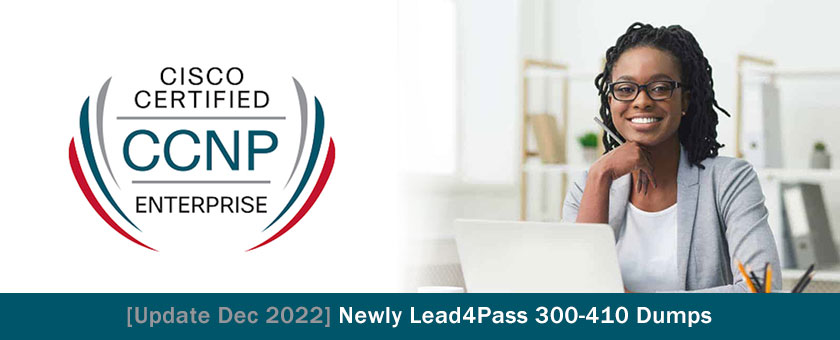
Lead4Pass 300-410 dumps ready! Verified by the Cisco expert team, real and effective!
The new 300-410 dumps contain 608 exam questions and answers and provide 300-410 dumps PDF and 300-410 dumps VCE two study programs to help candidates easily cope with the 300-410 ENARSI exam.
Welcome to download the new 300-410 dumps: https://www.leads4pass.com/300-410.html (Include 2022 Newest Simulation Labs), Guaranteed to pass successfully on the first attempt.
Download some of the new Cisco 300-410 pdfs available for free at Google Drive
https://drive.google.com/file/d/1B-r4PbrEKNrBNRiN6uIllaijaHFPkqMk/view?usp=share_link
https://drive.google.com/file/d/1C3Ny7fnTfs5Vn0f2RRHfve8ZUyogbf9m/view?usp=share_link
https://drive.google.com/file/d/1GA7Ozk2bKTyvwBiVoCyMSk2jVZ43AD2H/view?usp=share_link
https://drive.google.com/file/d/1Hmd2m8IlFiln0lDicik9brJDd0T1caJr/view?usp=share_link
https://drive.google.com/file/d/1Q5zIxqFRkF6FTyIj-xj2Q0nWn4J5Eg_X/view?usp=share_link
Read some of the new Cisco 300-410 dumps exam questions and answers available for free
| Number of exam questions | Exam name | From | Release time | Last updated |
| 15 | Implementing Cisco Enterprise Advanced Routing and Services (ENARSI) | Lead4Pass | Dec 02, 2022 | 300-410 dumps |
New Question 1:
Which command can you use to display the topological database maintained by an OSPF router?
A. show IP OSPF topology
B. show IP OSPF database
C. show IP OSPF [process-id]
D. show IP OSPF border-routers
Correct Answer: B
The correct answer is to show the IP OSPF database. The partial output is shown below:

Issuing the show IP OSPF database command will show you a summary of the database; however, to obtain details you must use a keyword with the command, such as a router, network, summary, or external.
The following commands are available to verify OSPF configurations:
show IP route – displays known routes and from which protocol the routes were discovered for all routing protocols.
show IP OSPF – displays the number of times the SPF algorithm has run and the default Link State Update (LSU) interval.
show IP OSPF database – displays the router ID, the OSPF process ID, and the contents of the topological database.
There is no show IP OSPF topology command.
The show IP OSPF [process-id] command can be used to view the number of times the SPF algorithm has been executed, but not to view the database.
The show IP OSPF border-routers command displays the ABRs and the routes to them, but not the contents of the database.
Objective:
Layer 3 Technologies
Sub-Objective:
Configure and verify OSPF path preference
References:
Cisco IOS Master Command List, Release 12.4T > sa IPsec through show IP route DHCP > show IP OSPF database
New Question 2:
Refer to the exhibit.

The engineer configured and connected Router2 to Router1. The link came up but could not establish a Telnet connection to Router1 IPv6 address of 2001:DB8::1.
Which configuration allows Router2 to establish a Telnet connection to Router1?
A. jpv6 unicast-routing
B. permit ICMPv6 on access list INGRESS for Router2 to obtain IPv6 address
C. permit IP any on access list EGRESS2 on Router1
D. IPv6 address on GigabitEthernet0/0
Correct Answer: D
A – wrong, it’s enabled as you configure and address
B – wrong, tested in a lab – even removing the access list completely doesn’t get R2 and IPv6 autoconfig address.
C – wrong, again even with no ACL nothing changes
D – fixed the issue with all ACLs in place.
New Question 3:
DRAG DROP
Drag and drop the MPLS VPN concepts from the left onto the correct descriptions on the right.
Select and Place:

Correct Answer:
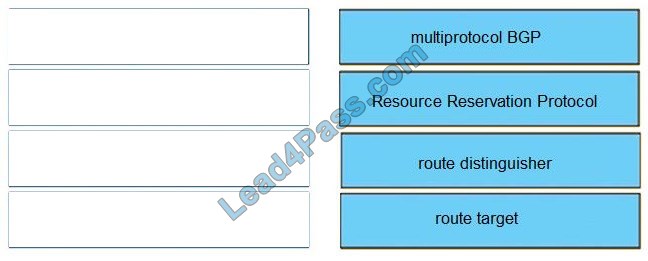
+
propagates VPN reachability information: multiprotocol BGP
+
distributes labels for traffic engineering: Resource Reservation Protocol
+
uniquely identifies a customer prefix: route distinguisher
+
controls the import/export of customer prefixes: route-target
Reference: https://www.rogerperkin.co.uk/featured/route-distinguisher-vs-route-target/
New Question 4:
Examine the following diagram:

Which of the following actions will make area 1 a totally stubby area? (Choose all that apply. Each correct answer is part of the solution.)
A. execute the area 1 stub no-summary command on RouterA
B. execute the area 1 stub no-summary command on RouterB
C. execute the area 1 stub command on RouterB
D. execute the area 1 stub command on RouterA
E. execute the area 0 stub-no summary command on RouterA
F. execute the area 0 stub no-summary command on RouterB
G. execute the area 0 stub command on RouterB
H. execute the area 0 stub command on RouterA
Correct Answer: AC
You should execute the area 1 stub no-summary command on RouterA and the area 1 stub command on RouterB. A totally stubby area is one that only keeps local area routes in the link-state database (LSDB), plus a default route that leads
out of the area. To make an area totally stubby, the area border router (ABR) should be configured with the area 1 stub no-summary command and all other area routers should be configured with the area 1 stub command. The diagram in the scenario indicates that RouterA is the border router.
You should not run any of the commands that refer to area 0. This would affect a different area than the requirement stated in the scenario.
None of the other combinations of actions will create a totally stubby area.
If you run the area 1 stub command on both RouterA and RouterB, it will create a stub area. A stub area differs from a totally stubby area in that a stub area will allow updates about areas in the same OSPF domain.
Objective:
Layer 3 Technologies
Sub-Objective:
Configure and verify network types, area types, and router types
References:
Cisco > Home > Support > Technology Support > IP > IP Routing > Design > Design Technotes > What Are OSPF Areas and Virtual Links? > Define a Totally Stub Area
New Question 5:
DRAG DROP
Drag and Drop the IPv6 First-Hop Security features from the left onto the definitions on the right.
Select and Place:

Correct Answer:
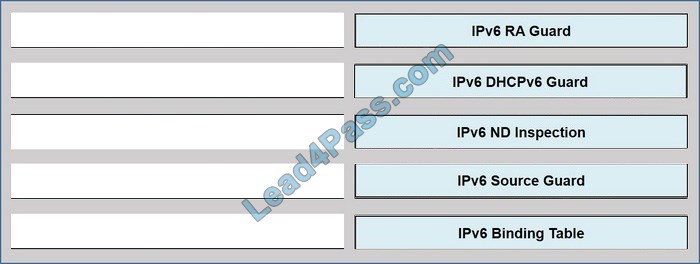
+
Block reply and advertisement messages from unauthorized DHCP servers and relay agents: IPv6 DHCPv6 Guard
+
Create a binding table that is based on NS and NA messages: IPv6 ND Inspection
+
Filter inbound traffic on Layer 2 switch ports that is not in the IPv6 binding table: IPv6 Source Guard
+
Block a malicious host and permit the router from a legitimate route: IPv6 RA Guard
+
Create IPv6 neighbors connected to the device from information sources such as NDP snooping: IPv6 Binding Table
New Question 6:
You need to configure eBGP on the rtrA and rtrB routers, as shown in the following image:

You have configured eBGP on rtrA through the following commands:
rtrA(config)# router BGP 501 rtrA(config)# neighbor 201.60.3.2 remote-as 505
While configuring eBGP on rtrB, you need to ensure that updates about the 192.168.58.0/24 and the 192.168.127.0/24 subnets are sent to rtrA with a metric of 300. In addition, rtrB should send updates about the 172.161.94.0/24 subnet are sent with a metric of 500.
Which of the following set of commands would NOT be part of the set used to correctly configure eBGP on rtrB?
A. access-list 1 permit 192.168.0.0 0.0.255.255 access-list 2 permit 172.161.94.0 0.0.0.255 router BGP 505 neighbor 201.60.3.1 remote-as 501 neighbor 201.60.3.1 route-map change_parameters in
B. access-list 1 permit 192.168.0.0 0.0.255.255 access-list 2 permit 172.161.94.0 0.0.0.255 router BGP 505 neighbor 201.60.3.1 remote-as 501 neighbor 201.60.3.1 route-map change_parameters out
C. route-map change_parameters permit 10 match IP-address 2 set metric 500
D. route-map change_parameters permit 20 match IP-address 1 set metric 300
Correct Answer: A
The following command set would NOT be used because it only applies the access list route-map change_parameters inbound instead of outbound, as would be required:
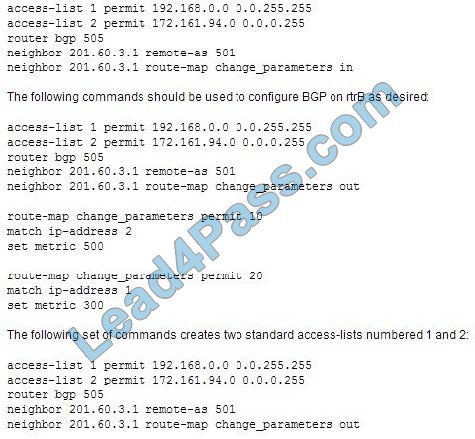
The ACL 1 allows the 192.168.58.0/24 and the 192.168.127.0/24 subnets, while the ACL 2 allows the 172.161.94.0/24 subnet. The neighbor route-map command specifies a route-map named change_parameters for the 201.60.3.1 BGP peer. The out keyword at the end of the command indicates that the route map is applied only to the updates sent by rtrB, and not received by rtrB.
In the following command, the route map change_parameters is defined with the permit keyword. The permit keyword indicates that if a match occurs, the actions specified in the set sub-command are executed:
route-map change_parameters permit 10 match IP-address 2 set metric 500
In this case, this command checks if the IP address of the subnets advertised to rtrA is in the 172.161.94.0/24 subnet (specified by ACL 2). If the IP address matches, then the metric of those routes is set to 500.
In the following command, the route map change_parameters is defined with the permit keyword:
route-map change_parameters permit 20
match IP-address 1
set metric 300
In this case, this command checks if the IP address of the subnets advertised to rtrA is in the 192.168.58.0/24 or the 192.168.127.0/24 subnets (specified by ACL 1) If the IP address matches, then the metric of those routes are set to 300.
Objective:
Layer 3 Technologies
Sub-Objective:
Configure and verify eBGP (IPv4 and IPv6 address families)
References:
Cisco > Home > Support > Technology Support > IP > IP Routing > Design > Design Technotes > BGP Case Studies > Route Maps
Cisco > Cisco IOS IP Routing: Protocol-Independent Command Reference > route-map
New Question 7:
R2 has a locally originated prefix 192.168.130.0/24 and has these configurations: What is the result when the route-map OUT command is applied toward an eBGP neighbor R1 (1.1.1.1) by using the neighbor 1.1.1.1 route-map OUT out command?

A. R1 sees 192.168.130.0/24 as two AS hops away instead of one AS hop away.
B. R1 does not accept any routes other than 192.168.130.0/24
C. R1 does not forward traffic that is destined for 192.168.30.0/24
D. Network 192.168.130.0/24 is not allowed in the R1 table
Correct Answer: A
New Question 8:
Which IGPs are supported by the MPLS LDP autoconfiguration feature?
A. RIPv2 and OSPF
B. OSPF and EIGRP
C. OSPF and ISIS
D. ISIS and RIPv2
Correct Answer: C
The MPLS LDP Autoconfiguration feature enables you to globally enable Label Distribution Protocol (LDP) on every interface associated with an Interior Gateway Protocol (IGP) instance.
This feature is supported on Open Shortest Path First (OSPF) and Intermediate System-to-Intermediate System (IS-IS) IGPS.
New Question 9:
Refer to the exhibit. R5 should not receive any routes originating in the EIGRP domain.
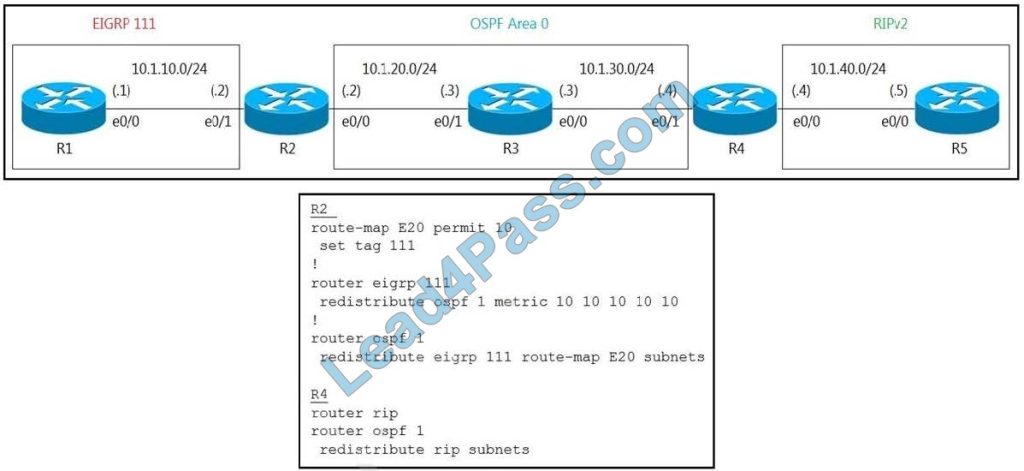
Which set of configuration changes removes the EIGRP routes from the R5 routing table to fix the issue?
A. R4 route-map O2R deny 10 match tag 111 route-map O2R permit 20! router rip redistribute OSPF 1 route-map O2R metric 1
B. R2 route-map E20 deny 20 R4 route-map O2R deny 10 match tag 111! router rip redistribute OSPF 1 route-map O2R metric 1
C. R4 route-map O2R permit 10 match tag 111 route-map O2R deny 20! router rip redistribute OSPF 1 route-map O2R metric 1
D. R4 route-map O2R deny 10 match tag 111! router rip redistribute OSPF 1 route-map O2R metric 1
Correct Answer: A
New Question 10:
A company is expanding business by opening 35 branches over the Internet. A network engineer must configure DMVPN at the branch routers to connect with the hub router and allow NHRP to add spoke routers securely to the multicast NHRP mappings automatically
Which configuration meets this requirement at the hub router?
A. interface Tunnel0 IP address 10.0.0.1 255.255.255.0 IP nbrp authentication KEY1 ip nhrp nhs dynamic IP nhop network-id 10 tunnel mode mgre auto
B. interface Tunnel0 IP address 10.0.0.1 255.255.255.0 ip nhrp authentication KEY1 ip nhrp registration no-unique IP nhrp network-id 10 tunnel mode gre nmba
C. interface Tunnel0 IP address 10.0.0.1 255.255.255.0 IP nhrp authentication KEY1 ip nhrp map multicast dynamic IP nbrp network-id 10 tunnel mode gre multipoint
D. interface Tunnel0 IP address 10.0.0.1 255.255.255.0 IP nhrp authentication KEY1 ip nhrp map multicast 224.0.0.0 IP nhrp network-id 10 tunnel mode gre ipv4
Correct Answer: C
New Question 11:
The network administrator has configured router R2 to redistribute a newly installed EIGRP network into their core OSPF network. The redistributed networks and subnets are not properly appearing in the routing tables of the other routers. The following output displays the partial configuration for router R2:
router OSPF 10 redistribute eigrp 50 metric 100 metric-type 1 network 192.16.31.0 0.0.0.255
What two modifications would correct the problem? (Choose two.)
A. Change the EIGRP AS number from 50 to 10
B. Change the AS number specified for OSPF to 50
C. Add the command network 10.0.0.0 0.0.0.255
D. Add the command network 10.0.0.0 255.255.255.0
E. Add the level-1-2 keyword to the redistribute command
F. Add the subnets keyword to the redistribute command
G. Change the command network 192.16.31.0 0.0.0.255 to include the area keyword and value
Correct Answer: FG
The R2 router will not form adjacencies with neighboring routers in the area if the area IDs do not match. The area keyword in the network command is missing from the initial router R2 configuration. The correct command would be:
R2(config)# network 192.16.31.0 0.0.0.255 area 1
Secondly, the subnets keyword should be used in the redistribute command to ensure that all of the subnets in the 10.0.0.0/8 are redistributed into OSPF. For example, you would use the following commands to redistribute EIGRP
autonomous system (AS) 50 networks and subnetworks into OSPF with a metric of 100 and advertise them as external Type 1 routes:
R2(config)# router OSPF
R2(config-router)# redistribute eigrp 50 metric 100 metric-type 1
The complete syntax for the redistribute command when used in OSPF is as follows:
redistribute protocol [process-id] [metric metric-value] [metric-type type-value] [subnets]
The command parameters are:
protocol – Identifies the source protocol, such as BGP, connected, EIGRP, IGRP, ISIS, OSPF, static, or rip. process-id – Depending on the routing protocol, identify the source autonomous system number or process ID.
metric – Identifies the seed metric for the redistributed route.
The default is 0. metric-type – For OSPF, it identifies the redistributed routes as either external Type 1 or Type 2 routes. The default is Type 2. subnets – Optional keyword for use with OSPF to indicate that the scope of the networks to be redistributed also includes subnets.
Objective:
Layer 3 Technologies
Sub-Objective:
Configure and verify redistribution between any routing protocols or routing sources
References:
Cisco > Cisco IOS IP Routing: Protocol-Independent Command Reference > redistribute (IP)
New Question 12:
Refer to the exhibit. The Internet traffic should always prefer Site-A ISP-1 if the link and BGP connection are up; otherwise, all Internet traffic should go to ISP-2. Redistribution is configured between BGP and OSPF routing protocols, and it is not working as expected.

What action resolves the issue?
A. Set OSPF Cost 200 at Site-A RTR1, and set OSPF Cost 100 at Site-B RTR2.
B. Set metric-type 2 at Site-A RTR1, and set metric-type 1 at Site-B RTR2.
C. Set metric-type 1 at Site-A RTR1, and set metric-type 2 at Site-B RTR2.
D. Set OSPF Cost 100 at Site-A RTR1, and set OSPF Cost 200 at Site-B RTR2.
Correct Answer: D
New Question 13:
Refer to the exhibit. An engineer is trying to block the route to 192.168.2.2 from the routing table by using the configuration that is shown. The route is still present in the routing table as an OSPF route. Which action blocks the route?

A. Use an extended access list instead of a standard access list.
B. Change sequence 10 in the route-map command from permit to deny.
C. Use a prefix list instead of an access list in the route map.
D. Add this statement to the route map: route-map RM-OSPF-DL deny 20.
Correct Answer: B
New Question 14:
Refer to the exhibit. AS 111 wanted to use AS 200 as the preferred path for 172.20.5.0/24 and AS 100 as the backup. After the configuration, AS 100 is not used for any other routes. Which configuration resolves the issue?
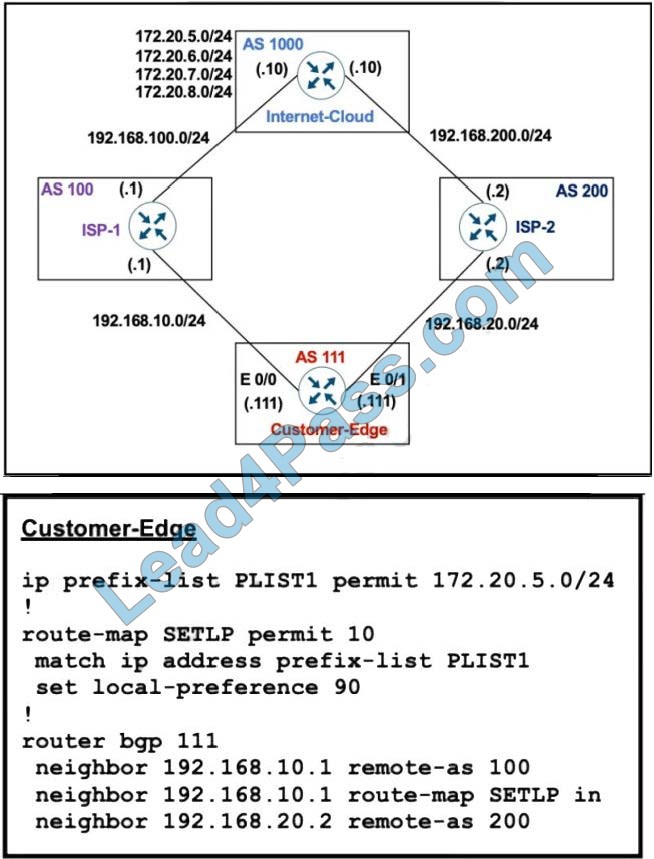
A. route-map SETLP permit 10 match IP address prefix-list PLIST1 set local-preference 110 route-map SETLP permit 20
B. route-map SETLP permit 10 match IP address prefix-list PLIST1 set local-preference 99 route-map SETLP permit 20
C. router BGP 111 no neighbor 192.168.10.1 route-map SETLP in neighbor 192.168.20.2 route-map SETLP in
D. router BGP 111 no neighbor 192.169.10.1 route-map SETLP in neighbor 192.168.10.1 route-map SETLP out
Correct Answer: B
There is an implicit deny-all at the end of any route map so all other traffic that does not match 172.20.5.0/24 would be dropped. Therefore we have to add a permit sequence at the end of the route map to allow other traffic. The default value of Local Preference is 100 and a higher value is preferred so we have to set the local preference of AS100 lower than that of AS200.
New Question 15:
Refer to the exhibit.

An engineer is trying to get 192.168.32.100 forwarded through 10.1.1.1, but it was forwarded through 10.1.1.2.
What action forwards the packets through 10.1.1.1?
A. Configure EIGRP to receive 192.168.32.0 route with lower admin distance.
B. Configure EIGRP to receive the 192.168.32.0 route with a longer prefix than /19.
C. Configure EIGRP to receive the 192.168.32.0 route with a lower metric.
D. Configure EIGRP to receive 192.168.32.0 route with equal or longer prefix than /24.
Correct Answer: D
…
Lead4pass updates Cisco 300-410 ENARSI exam questions and answers throughout the year to ensure you pass the exam smoothly. Select lead4Pass 300-410 dumps: https://www.leads4pass.com/300-410.html to pass the Cisco 300-410 ENARSI exam “Implementing Cisco Enterprise Advanced Routing and Services”.
BTW, giving away some free Cisco 300-410 pdfs for candidate reference:
https://drive.google.com/file/d/1B-r4PbrEKNrBNRiN6uIllaijaHFPkqMk/view?usp=share_link
https://drive.google.com/file/d/1C3Ny7fnTfs5Vn0f2RRHfve8ZUyogbf9m/view?usp=share_link
https://drive.google.com/file/d/1GA7Ozk2bKTyvwBiVoCyMSk2jVZ43AD2H/view?usp=share_link
https://drive.google.com/file/d/1Hmd2m8IlFiln0lDicik9brJDd0T1caJr/view?usp=share_link
https://drive.google.com/file/d/1Q5zIxqFRkF6FTyIj-xj2Q0nWn4J5Eg_X/view?usp=share_link

